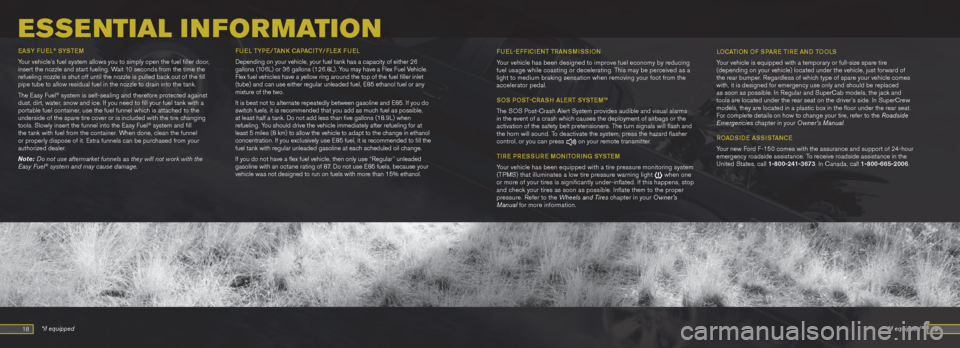tire type FORD F150 2013 12.G Quick Reference Guide
[x] Cancel search | Manufacturer: FORD, Model Year: 2013, Model line: F150, Model: FORD F150 2013 12.GPages: 10, PDF Size: 6.81 MB
Page 10 of 10

18 19
ESSE NtIaL I N FoRmat Io N
EaSY FUEL® SYSTE M
Your vehicle’s fuel system allows you to simply open the fuel filler door,
insert the nozzle and start fueling. Wait 10 seconds from the time the
refueling nozzle is shut off until the nozzle is pulled back out of the fill
pipe tube to allow residual fuel in the nozzle to drain into the tank.
The Easy Fuel
® system is self-sealing and therefore protected against
dust, dirt, water, snow and ice. If you need to fill your fuel tank with a
portable fuel container, use the fuel funnel which is attached to the
underside of the spare tire cover or is included with the tire changing
tools. Slowly insert the funnel into the Easy Fuel
® system and fill
the tank with fuel from the container. When done, clean the funnel
or properly dispose of it. Extra funnels can be purchased from your
authorized dealer.
Note: Do not use aftermarket funnels as they will not work with the
Easy Fuel
® system and may cause damage. FUEL
TYPE /TanK Ca Pa C iTY /FLEx FUEL
Depending on your vehicle, your fuel tank has a capacity of either 26
gallons (106L) or 36 gallons (126.8L). You may have a Flex Fuel Vehicle.
Flex fuel vehicles have a yellow ring around the top of the fuel fille\
r inlet
(tube) and can use either regular unleaded fuel, E85 ethanol fuel or any
mixture of the two.
It is best not to alternate repeatedly between gasoline and E85. If you do
switch fuels, it is recommended that you add as much fuel as possible,
at least half a tank. Do not add less than five gallons (18.9L) when
refueling. You should drive the vehicle immediately after refueling for at
least 5 miles (8 km) to allow the vehicle to adapt to the change in ethanol
concentration. If you exclusively use E85 fuel, it is recommended to fill the
fuel tank with regular unleaded gasoline at each scheduled oil change.
If you do not have a flex fuel vehicle, then only use “Regular” unleaded
gasoline with an octane rating of 87. Do not use E85 fuels, because your
vehicle was not designed to run on fuels with more than 15% ethanol. F
UEL -EFF iC iEn T T RanSMiSSi On
Your vehicle has been designed to improve fuel economy by reducing
fuel usage while coasting or decelerating. This may be perceived as a
light to medium braking sensation when removing your foot from the
accelerator pedal.
SOS P OST-CRaSH aLERT SYSTEM ™
The SOS Post-Crash Alert System provides audible and visual alarms
in the event of a crash which causes the deployment of airbags or the
activation of the safety belt pretensioners. The turn signals will flash and
the horn will sound. To deactivate the system, press the hazard flasher
control, or you can press
on your remote transmitter.
TiRE PRESSURE MOni TORing S YSTEM
Your vehicle has been equipped with a tire pressure monitoring system
(TPMS) that illuminates a low tire pressure warning light
when one
or more of your tires is significantly under-inflated. If this happe\
ns, stop
and check your tires as soon as possible. Inflate them to the proper
pressure. Refer to the Wheels and Tires chapter in your Owner’s
Manual for more information. L
OC aTiOn OF SPaRE TiRE an D T OOLS
Your vehicle is equipped with a temporary or full-size spare tire
(depending on your vehicle) located under the vehicle, just forward of
the rear bumper. Regardless of which type of spare your vehicle comes
with, it is designed for emergency use only and should be replaced
as soon as possible. In Regular and SuperCab models, the jack and
tools are located under the rear seat on the driver’s side. In SuperCrew
models, they are located in a plastic box in the floor under the rear seat.
For complete details on how to change your tire, refer to the Roadside
Emergencies chapter in your Owner’s Manual.
RO aDS iDE aSS iST anCE
Your new Ford F-150 comes with the assurance and support of 24-hour
emergency roadside assistance. To receive roadside assistance in the
United States, call 1-800-241-3673. In Canada, call 1-800-665-2006.
*if equipped
*if equipped